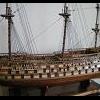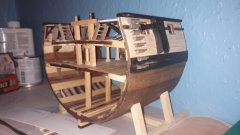-
Posts
596 -
Joined
-
Last visited
Reputation Activity
-
 Dziadeczek got a reaction from mtaylor in HMS Victory by ronald305 - Model Space
Dziadeczek got a reaction from mtaylor in HMS Victory by ronald305 - Model Space
Ronald,
Check it out, what Gebhard Kammerlander does with wet wood strips and a hot soldering iron.
The video is rather old and not the best quality, and in German, but you can see what is possible with this technique and what is not.
You do not have to use his electric plank bender, just a regular soldering iron should suffice (with a heat control, if possible, not to burn the wood).
Besides, the degree of wood bending also depends on wood species your planks are made of. Some wood is quite brittle, some very stiff and springly and some very pliable (pear, and somewhat stiffer cherry). The thinner the plank is, the more you can bend it, all the way up to 360 degrees!
Pre wet your planks in luke warm water for 5 - 10 minutes and, while they are wet, heat bend them to a desired curve. Sometimes you have to do it in stages, wetting them and bending, and so on. If you overbend your wood, you can unbend it - using the same technique.
Your planks look rather brittle, I don't know the wood specie (perhaps mahogany?), but you might try to replace them with some fruitwood and heat bend them, instead of using the planks supplied in the kit.
Good luck!
Thomas
-
 Dziadeczek got a reaction from Gregory in HMS Victory by ronald305 - Model Space
Dziadeczek got a reaction from Gregory in HMS Victory by ronald305 - Model Space
Ronald,
Check it out, what Gebhard Kammerlander does with wet wood strips and a hot soldering iron.
The video is rather old and not the best quality, and in German, but you can see what is possible with this technique and what is not.
You do not have to use his electric plank bender, just a regular soldering iron should suffice (with a heat control, if possible, not to burn the wood).
Besides, the degree of wood bending also depends on wood species your planks are made of. Some wood is quite brittle, some very stiff and springly and some very pliable (pear, and somewhat stiffer cherry). The thinner the plank is, the more you can bend it, all the way up to 360 degrees!
Pre wet your planks in luke warm water for 5 - 10 minutes and, while they are wet, heat bend them to a desired curve. Sometimes you have to do it in stages, wetting them and bending, and so on. If you overbend your wood, you can unbend it - using the same technique.
Your planks look rather brittle, I don't know the wood specie (perhaps mahogany?), but you might try to replace them with some fruitwood and heat bend them, instead of using the planks supplied in the kit.
Good luck!
Thomas
-

-
 Dziadeczek got a reaction from mtaylor in Rigging a capstan
Dziadeczek got a reaction from mtaylor in Rigging a capstan
Why did you enclose plans for the USS Constitution?
This link Ship Model Laboratory - Centre for Maritime Archaeology and Conservation - Texas A&M University (tamu.edu) explain the whole process well, and even though it doesn't apply to the Wappen von Hamburg, but the principle is the same.
-
 Dziadeczek got a reaction from Edward Stein in Rigging a capstan
Dziadeczek got a reaction from Edward Stein in Rigging a capstan
Why did you enclose plans for the USS Constitution?
This link Ship Model Laboratory - Centre for Maritime Archaeology and Conservation - Texas A&M University (tamu.edu) explain the whole process well, and even though it doesn't apply to the Wappen von Hamburg, but the principle is the same.
-
 Dziadeczek got a reaction from EricWilliamMarshall in Excellent Book for Model Ship Builders
Dziadeczek got a reaction from EricWilliamMarshall in Excellent Book for Model Ship Builders
Don't forget that there is also an excellent brochure "Planking the built-up Ship Models" by the late Jim Roberts. I actually learnt how to spil and plank based on this particular brochure.
-
 Dziadeczek got a reaction from EricWilliamMarshall in Excellent Book for Model Ship Builders
Dziadeczek got a reaction from EricWilliamMarshall in Excellent Book for Model Ship Builders
And I have these two:
-
 Dziadeczek got a reaction from Obormotov in Harold Hahn method
Dziadeczek got a reaction from Obormotov in Harold Hahn method
Years ago I built my French 74 gun ship upside down, mounted in H. Hahn's building base, following his method (sort of). I remember, I had to add (draw) the remaining frames, since J. Boudriot only has shown in his books the so called, station frames. The hull turned out OK, not perfect though, but - for the first scratch built, Admiralty type model, - acceptable.
Right now I am starting to install the running rigging on it.
Thomas
-
 Dziadeczek got a reaction from measuretwice in Lathe
Dziadeczek got a reaction from measuretwice in Lathe
"The Home Machinist's Handbook" by Doug Briney and
"Tabletop Machining" by Joe Martin
Both are talking mostly about the Sherline, but general principles are the same for all.
-
 Dziadeczek reacted to Gaetan Bordeleau in 74-gun ship by Gaetan Bordeleau - 1:24
Dziadeczek reacted to Gaetan Bordeleau in 74-gun ship by Gaetan Bordeleau - 1:24
Thank you Brian
but there are also angles which look bad. Photography can be a great liar. The lens sees completely different things than what the human eye sees but fortunately for us, sometime it looks good and often it is just a matter of luck.
-
 Dziadeczek reacted to giampieroricci in HMS PEGASUS by giampieroricci - Scale 1:36 - Swan-Class Sloop from plans by David Antscherl & Greg Herbert
Dziadeczek reacted to giampieroricci in HMS PEGASUS by giampieroricci - Scale 1:36 - Swan-Class Sloop from plans by David Antscherl & Greg Herbert
I have finished the nailing.
7588 nails have been driven so far.....😄
-
 Dziadeczek reacted to Bitao in NAIAD 1797 by Bitao - 1:60
Dziadeczek reacted to Bitao in NAIAD 1797 by Bitao - 1:60
Thank you for your attention and support over the past year! And a merry Christmas to you all in advance!
-
 Dziadeczek got a reaction from GrandpaPhil in Ship paintings
Dziadeczek got a reaction from GrandpaPhil in Ship paintings
This painting reminds me of another one - a large mural in the Air Museum in Palm Springs, California... Different ships, different planes though, but...
Thanks! 🙂
-
 Dziadeczek got a reaction from ccoyle in Ship paintings
Dziadeczek got a reaction from ccoyle in Ship paintings
This painting reminds me of another one - a large mural in the Air Museum in Palm Springs, California... Different ships, different planes though, but...
Thanks! 🙂
-
 Dziadeczek got a reaction from JpR62 in Ship paintings
Dziadeczek got a reaction from JpR62 in Ship paintings
This painting reminds me of another one - a large mural in the Air Museum in Palm Springs, California... Different ships, different planes though, but...
Thanks! 🙂
-
 Dziadeczek got a reaction from reklein in Ship paintings
Dziadeczek got a reaction from reklein in Ship paintings
This painting reminds me of another one - a large mural in the Air Museum in Palm Springs, California... Different ships, different planes though, but...
Thanks! 🙂
-
 Dziadeczek got a reaction from BLACK VIKING in Ship paintings
Dziadeczek got a reaction from BLACK VIKING in Ship paintings
This painting reminds me of another one - a large mural in the Air Museum in Palm Springs, California... Different ships, different planes though, but...
Thanks! 🙂
-
 Dziadeczek reacted to marsalv in Le Gros Ventre by marsalv - FINISHED - 1:48 - POF
Dziadeczek reacted to marsalv in Le Gros Ventre by marsalv - FINISHED - 1:48 - POF
Thank you albert.
Forecastle and quaterdeck breastwork.
-
 Dziadeczek got a reaction from mtaylor in Ship paintings
Dziadeczek got a reaction from mtaylor in Ship paintings
This painting reminds me of another one - a large mural in the Air Museum in Palm Springs, California... Different ships, different planes though, but...
Thanks! 🙂
-
 Dziadeczek got a reaction from Edwardkenway in Ship paintings
Dziadeczek got a reaction from Edwardkenway in Ship paintings
This painting reminds me of another one - a large mural in the Air Museum in Palm Springs, California... Different ships, different planes though, but...
Thanks! 🙂
-
 Dziadeczek got a reaction from Canute in Lathe
Dziadeczek got a reaction from Canute in Lathe
I recently turned all yards for my "Frenchie" on my Sherline lathe (long bed type). With the exception of a few shortest ones, all others were too long to do it from one square piece of wood. So I had to do them in sections (three), two 'arms' and one center octagonal piece. Afterwards I glued them together with round pegs (flutted dowels) and Titebond glue into predrilled holes. The joints are invisible.
-
 Dziadeczek got a reaction from Canute in Lathe
Dziadeczek got a reaction from Canute in Lathe
"The Home Machinist's Handbook" by Doug Briney and
"Tabletop Machining" by Joe Martin
Both are talking mostly about the Sherline, but general principles are the same for all.
-
 Dziadeczek got a reaction from Canute in Lathe
Dziadeczek got a reaction from Canute in Lathe
With a metal lathe you can turn soft metals (brass, copper, aluminum and perhaps even soft steel) as well as wood, but with a wood lathe you can only turn wood.
Good quality lathe (Sherline, Proxxon, Taig) doesn't come cheaply, though... On the other hand, it is an investment for life...
-
 Dziadeczek got a reaction from BETAQDAVE in Ship paintings
Dziadeczek got a reaction from BETAQDAVE in Ship paintings
This painting reminds me of another one - a large mural in the Air Museum in Palm Springs, California... Different ships, different planes though, but...
Thanks! 🙂
-
 Dziadeczek got a reaction from Canute in Ship paintings
Dziadeczek got a reaction from Canute in Ship paintings
This painting reminds me of another one - a large mural in the Air Museum in Palm Springs, California... Different ships, different planes though, but...
Thanks! 🙂




.thumb.jpeg.fc5d633a7b34428fcf19419a73d56d55.jpeg)






